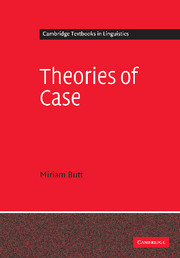Summary
So she began: ‘O Mouse, do you know the way out of this pool? I am very tired of swimming about here, O Mouse!’ (Alice thought this must be the right way of speaking to a mouse: she had never done such a thing before, but she remembered having seen in her brother's Latin Grammar, ‘A mouse – of a mouse – to a mouse – a mouse – O mouse!’)
[Lewis Carroll, Alice's Adventures in Wonderland, p. 28]Overview
This book is meant to serve as an introduction to various notions of case within modern theoretical linguistics. In order to tackle such an undertaking, several issues must be dealt with. One is the issue of what “case” really means. Another is the question as to which historically motivated assumptions have served to form our current notion of case. This book is written primarily from a syntactic point of view and therefore surveys a treatment of case as proposed within various theories of syntax, unavoidably, however, it also touches on semantic and morphological issues along the way.
Modern syntactic theories did not appear out of thin air (though that may appear to be the case to some, given the tremendous impact of the Chomskyan revolution in the 50s and 60s within theoretical linguistics). Rather, modern linguistic thought as practised in the Western world is informed directly by unbroken grammatical traditions which date back to the ancient Greek and Roman world.
- Type
- Chapter
- Information
- Theories of Case , pp. 1 - 11Publisher: Cambridge University PressPrint publication year: 2006
- 1
- Cited by



